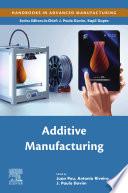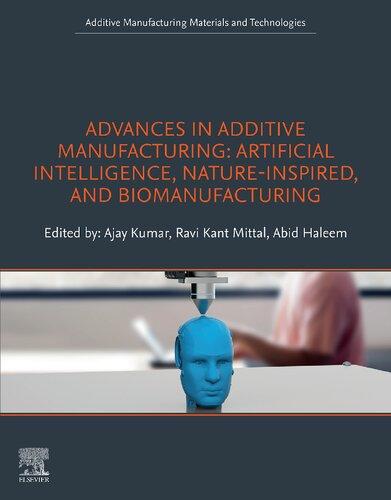https://ebookmass.com/product/additivemanufacturing-1st-edition-juan-pou-antonio-

More products digital (pdf, epub, mobi) instant download maybe you interests ...

Metal Additive Manufacturing Ehsan Toyserkani
https://ebookmass.com/product/metal-additive-manufacturing-ehsantoyserkani/

Fast Desktop-Scale Extrusion Additive Manufacturing (Article, NOT a book) Jamison Go
https://ebookmass.com/product/fast-desktop-scale-extrusionadditive-manufacturing-article-not-a-book-jamison-go/

Fundamentals of Additive Manufacturing for the Practitioner Sheku Kamara
https://ebookmass.com/product/fundamentals-of-additivemanufacturing-for-the-practitioner-sheku-kamara/

Additive and Traditionally Manufactured Components: A Comparative Analysis of Mechanical Properties (Additive Manufacturing Materials and Technologies) 1st Edition Joshua Pelleg Phd
https://ebookmass.com/product/additive-and-traditionallymanufactured-components-a-comparative-analysis-of-mechanicalproperties-additive-manufacturing-materials-and-technologies-1st-

Additive Manufacturing for the Aerospace Industry
Francis Froes & Rodney Boyer
https://ebookmass.com/product/additive-manufacturing-for-theaerospace-industry-francis-froes-rodney-boyer/

Nanotechnology-Based Additive Manufacturing: Product Design, Properties, and Applications Volumes 1-2 1st Edition Kalim Deshmukh
https://ebookmass.com/product/nanotechnology-based-additivemanufacturing-product-design-properties-and-applicationsvolumes-1-2-1st-edition-kalim-deshmukh/

Advances in Additive Manufacturing: Artificial Intelligence, Nature-Inspired, and Biomanufacturing Ajay Kumar
https://ebookmass.com/product/advances-in-additive-manufacturingartificial-intelligence-nature-inspired-and-biomanufacturingajay-kumar/

Digital Manufacturing: The Industrialization of "Art to Part" 3D Additive Printing Chandrakant D. Patel
https://ebookmass.com/product/digital-manufacturing-theindustrialization-of-art-to-part-3d-additive-printingchandrakant-d-patel/

Smart Materials in Additive Manufacturing, Volume 1: 4D Printing Principles and Fabrication Mahdi Bodaghi
https://ebookmass.com/product/smart-materials-in-additivemanufacturing-volume-1-4d-printing-principles-and-fabricationmahdi-bodaghi/

Additive Manufacturing
Editors
Juan Pou
Antonio Riveiro

Table of Contents
Cover image
Title page
Copyright
Contributors
Foreword
Preface
Chapter 1. Introduction to additive manufacturing
1.1. Basic concepts of additive manufacturing
1.2. Basic procedure of additive manufacturing
1.3. Categories of additive manufacturing
1.4. Applications of additive manufacturing
1.5. Comparison of additive manufacturing and subtractive manufacturing
1.6. Hybrid manufacturing
1.7. Challenges and limitations of current additive manufacturing
Chapter 2. Introduction to powder bed fusion of polymers
2.1. Introduction
2.2. Processes, machines, technologies
2.3. Postprocessing and surface treatment
2.4. Materials and powder production techniques for powder bed fusion
2.5. Parameter settings and influences
2.6. Process monitoring
Symbols
Abbreviations
Chapter 3. Selective laser melting: principles and surface quality
3.1. Introduction to selective laser melting
3.2. Surface integrity in the selective laser melting process
3.3. Treatments applied during the selective laser melting process
3.4. Treatments applied after the selective laser melting process
Chapter 4. Laser-directed energy deposition: principles and applications
4.1. Introduction
4.2. Principles of laser-directed energy deposition
4.3. Industrial applications of laser-directed energy deposition
4.4. Biomedical applications of laser-directed energy deposition
4.5. Summary
Chapter 5. Vat photopolymerization methods in additive manufacturing
5.1. Introduction
5.2. Vat photopolymerization process
5.3. Postprocessing
5.4. Direct fabrication of parts by vat photopolymerization
5.5. Additive manufacturing technologies for tooling
Chapter 6. Polymer and composites additive manufacturing: material extrusion processes
6.1. Introduction
6.2. Extrusion additive manufacturing processes
6.3. Hybrid systems
6.4. In-line monitoring and automation for smart manufacturing
6.5. Materials development
6.6. Current applications and path forward
Chapter 7. Introduction to fused deposition modeling
7.1. Historical outline and used labels
7.2. The RepRap project—history and models of 3D printers
7.3. Model and support materials
7.4. Extrusion head structure
7.5. Selected details about heads in open systems
7.6. An example of head construction in a Stratasys device
7.7. Fiber deposition strategy and finishing process
7.8. Conclusions
Chapter 8. Electron beam melting process: a general overview
8.1. Introduction
8.2. Electron beam melting physical mechanisms
8.3. Process control and process parameters
8.4. Part features
8.5. Process monitoring
8.6. Numerical simulation
8.7. Summary and scientific and technological challenges
Chapter 9. Introduction to 4D printing: methodologies and materials
9.1. Introduction
9.2. Fundamentals of 4D printing
9.3. Material extrusion-based 4D printing
9.4. 4D printing by polyjet printing
9.5. Vat photopolymerization-based 4D printing
9.6. Summary
Chapter 10. Laser polishing of additive-manufactured Ti alloys and Ni alloys
10.1. Introduction
10.2. Laser polishing LMD TC11
10.3. Laser polishing SLM TC4
10.4. Laser polishing SLM inconel 718 superalloy
10.5. Conclusions
Chapter 11. On surface quality of engineered parts manufactured by additive manufacturing and postfinishing by machining
11.1. Introduction
11.2. Surface roughness
11.3. Experimental studies on additive manufacturing and machining
11.4. Challenges and opportunities
11.5. Conclusions
Chapter 12. Standards for additive manufacturing technologies: structure and impact
12.1. Introduction
12.2. Structure of additive manufacturing standardization working groups
12.3. Published AM standards in ISO/ASTM
12.4. Impact of standards for additive manufacturing
12.5. Conclusions
Chapter 13. Metal matrix composites processed by laser additive manufacturing: microstructure and properties
13.1. Introduction
13.2. In situ synthesis of metal matrix composites by laser additive manufacturing
13.3. Laser additive manufacturing for the production of “pure” ex situ metal matrix composites
13.4. Laser additive manufacturing of hierarchical metal matrix composites
13.5. Microstructural characterization of metal matrix composites produced by laser additive manufacturing
13.6. Properties and applications of metal matrix composites produced by laser additive manufacturing
13.7. Concluding remarks
Chapter 14. Laser aided metal additive manufacturing and postprocessing: a comprehensive review
14.1. Introduction
14.2. Laser additive metal manufacturing
14.3. Postprocessing techniques for additive manufactured components
14.4. Future scope of laser-based additive manufacturing
Chapter 15. Nanofunctionalized 3D printing
15.1. Introduction
15.2. Nanoenhancement of structural materials
15.3. 3D-printed electronics, optics, and energy conversion devices
15.4. 3D-printed nanocomposites used in medicine
15.5. Additive-manufactured nanofunctionalized surfaces
15.6. Conclusions
Abbreviations
Chapter 16. Additive manufacturing for the automotive industry
16.1. Introduction
16.2. Complementary methods and techniques
16.3. Overview of additive manufacturing applications on automotive production tools
16.4. Hard tools for mass-scale replication of automotive components
16.5. Emerging additive manufacturing applications on automotive components
16.6. Economic impact of additive manufacturing applications on the automotive industry
16.7. Conclusions
Chapter 17. Additive manufacturing of large parts
17.1. Direct laser deposition process simulation
17.2. Residual stresses and distortion in direct laser deposition of large parts
17.3. Technological equipment in direct laser deposition of large parts
17.4. Structure and properties of products obtained by direct laser deposition technology
17.5. Conclusions
Chapter 18. 3D printing of pharmaceutical products
18.1. Introduction
18.2. Pharmaceutical 3D printing technologies
18.3. 3D printing: a new era of personalized medicine
Chapter 19. 3D bioprinting: a step forward in creating engineered human tissues and organs
19.1. Introduction
19.2. Bioprinting technologies
19.3. Bioinks
Another random document with no related content on Scribd:
Then beside the manual employment which our commercial institutions provide there are innumerable trading posts and clerkships, connected with merchants’ houses, banks, railways, post-offices, and all manner of public works, all of which practically are filled by natives; and some of which, with the moderate salaries attached, are eagerly sought after. One hardly realises till one sees it, how completely these great organizations are carried on—except for perhaps one or two Englishmen at the head—by native labor; but when one does see this one realises also how important a part of the whole population this section—which is thus ministering to and extending the bounds of modern life—is becoming. And this section again is supplemented by at least an equally numerous section which, if not already employed in the same way, is desirous of becoming so. And of course among both these sections Western ideals and standards flourish; competition is gradually coming to be looked on as a natural law of society; and Caste and the old Family system are more or less rapidly disintegrating.
Such changes as these are naturally important, and indeed in an old and conservative country like India strike one as very remarkable— but they are made even more important by the political complexion they have of late years assumed. In the National Indian Congress we see that not only the outer forms of life and thought, but the political and social ideas which belong to the same stage of historical development, have migrated from West to East. The people—or at least those sections of it of which we are speaking—are infected not only with Darwin and Huxley, but with a belief in the ballot, in parliaments and town-councils, and in constitutionalism and representative government generally. The N. I. C. brings together from 1,000 to 1,500 delegates annually from all parts of India, representing a variety of different races and sections, and elected in many of the larger towns with the utmost enthusiasm; and this by itself is a striking fact—a fact quite comparable in its way with the meetings of the Labor Congresses in late years in the capitals of Europe. Its conferences have been mostly devoted to such political questions as the application
of the elective principle to municipal and imperial councils, and to such social questions as that of child-marriage; and these subjects and the speeches concerning them are again reviewed and reported by a great number of newspapers printed both in English and the vernacular tongues, and having a large circulation. Certainly it is probable that the Congresses will not immediately lead to any very striking results— indeed it is hard to see how they could do so; but the fact of the existence of the N. I. C. movement alone is a pregnant one, and backed as it is by economical changes, it is not likely—though it may change its form—to evaporate into mere nothingness.
In fact—despite the efforts of certain parties to minimise it—it seems to me evident that we are face to face with an important social movement in India. What the upshot of it may be no one probably can tell—it may subside again in time, or it may gather volume and force towards some definite issue; but it certainly cannot be ignored. The Pagetts, M.P., may be ponderously superficial about it, but the Kiplings merry are at least equally far from the truth. Of course in actual numerical strength as compared with the whole population the party may be small; but then, as in other such movements, since it is just the most active and energetic folk who join them, their import cannot be measured by mere numbers. It is useless again to say that because the movement is not acknowledged by the peasants, or by the religious folk, or because it is regarded with a jealous eye by certain sections, that therefore it is of no account; because similar things are always said and always have been said of every new social effort—in its inception—however popular or influential it may afterwards become.
The question which is most interesting at this juncture to any one who recognises that there really is something like a change of attitude taking place in the Indian peoples, is: How do the Anglo-Indians regard this change? and my answer to this—though given with diffidence—since it is a large generalisation and there may be, certainly are, many exceptions to it—is: I believe that taken as a whole the Anglos look upon it with a mingled sentiment of Fear and Dislike. I think they look upon the movement with a certain amount of Fear perhaps not unnaturally. The remembrance of the Mutiny of ’57 is
before them; they feel themselves to be a mere handful among millions. And I am sure they look upon it with Dislike, for as said above there is no real touch, no real sympathy, between them and the native races. However it may be for the liberalising Englishman at home to indulge in a sentimental sympathy with the aspiring oyster, the Britisher in India feels that the relation is only tolerable as long as there is a fixed and impassable distinction between the ruler and the ruled. Take that away, let the two races come into actual contact on an equality, and ... but the thought is not to be endured.
And this feeling of race-dislike is I think—as I have hinted in an earlier chapter—enhanced by the fact that the Britisher in India is a “class” man in his social feeling. I have several times had occasion to think that the bulk-people of the two countries—though by no means agreeing with each other would, if intercourse were at all possible, get on better together than the actual parties do at present. The evils of a commercial class-government which we are beginning to realise so acutely at home—the want of touch between the rulers and the ruled, the testing of all politics by the touchstone of commercial profits and dividends, the consequent enrichment of the few at the expense of the many, the growth of slum and factory life, and the impoverishment of the peasant and the farmer, are curiously paralleled by what is taking place in India; and in many respects it is becoming necessary to realise that some of our difficulties in India are not merely such as belong to the country itself, but are part and parcel of the same problem which is beginning to vex us at home—the social problem, namely. The same narrowness of social creed, the entire decadence of the old standards of gentle birth without their replacement by any new ideal, worthy to be so called, the same trumpery earmarks of society-connection, etc., distinguish the ruling classes in one country as in the other; and in both are the signals of coming change.
At the same time it would be absurd to assume that the native of India is free from serious defects which make the problem, to the Anglo-Indian, ever so much more difficult of solution. And of these probably the tendency to evasion, deceit, and underhand dealing is the most serious. The Hindu especially with his subtle mind and passive
character is thus unreliable; it is difficult to find a man who will stick with absolute fidelity to his word, or of whom you can be certain that his ostensible object is his real one; and naturally this sort of thing creates estrangement.
To my mind this social gulf existing between the rulers and the ruled is the most pregnant fact of our presence in India—the one that calls most for attention, and that looms biggest with consequences for the future. Misunderstandings of all kinds flow from it. “When this want of intercourse,” says Beck in his Essays on Indian Topics, “between the communities or a reasonable number of people of each, is fixed on my attention, I often feel with a sinking of the heart that the end of the British Indian Empire is not far distant.”
I have already pointed out (p. 276) how clear it is by the example of Aligarh that friendly intercourse is possible between the two sections—though we have allowed that it is difficult to bring about. Mr. Beck corroborates this in his Essaysby strong expressions. He says (p. 89), “An Englishman would probably be dubbed a lunatic if he confessed that the only thing which made life tolerable in his Indian exile was the culture, the interest, and the affection he found in native society. Such an Englishman will therefore at most hint at his condition”; and again—“As one whose circumstances have compelled him to see more of the people of India than the average Englishman, I can only say that the effort repays itself, and that, incredible though it may appear, all degrees of friendship are possible between the AngloIndian and his Eastern fellow-subject.” And further on, after urging the importance, the vast importance, of cultivating this intercourse, and so attempting to bridge the fatal gulf, he says:—“To know the people, and to be so trusted by them that they will open out to us the inmost recesses of their hearts; to see them daily; to come to love them as those who have in their nature but an average share of affection cannot help loving them when they know them well—this is our ideal for the Indian civilian. Some Englishmen act up to this ideal: in the early days of our rule several did. If it become the normal thing the Indian Empire will be built upon a rock so that nothing can shake it. Agitation and sedition will vanish as ugly shadows. Had it existed in 1857 the crash would not have come.”
The writer of the above paragraphs thinks nothing of the N. I. C. movement, or rather I should say thinks unfavorably of it; but of the importance of bridging the social gulf he cannot say enough—and in this latter point, as far as I feel competent to form an opinion at all, I entirely agree with him. But will it ever be bridged? Unfortunately the few who share such sentiments as those I have quoted are very few and far between—and of those the greater number must as I have already explained be tied and bound in the chains of officialdom. “The Anglo-Indian world up to the hour when the great tragedy of ’57 burst upon them was busily amusing itself as best it can in this country with social nothings”—and how is it amusing itself now? The most damning fact that I know against the average English attitude towards the natives, is the fact that one of the very few places besides Aligarh, where there is any cordial feeling between the two parties, is Hyderabad—a place in which, on account of its being under the Nizam, the officials are natives, and their position therefore prevents their being trampled on!
If the Congress movement is destined to become a great political movement, it must it seems to me eventuate in one of two ways— either in violence and civil war, owing to determined hostility on the part of our Government and the continual widening of the breach between the two peoples; or,—which is more likely—if our Government grants more and more representative power to the people—in the immense growth of political and constitutional life among them, and the gradual drowning out of British rule thereby. There is a third possibility—namely the withdrawal of our government, owing to troubles and changes at home. Either of these alternatives would only be the beginning of long other vistas of change, which we need not attempt to discuss. They all involve the decadence of our political power in India, and certainly, situated as we are—unable to really inhabit the country and adapt ourselves to the climate, and with growing social forces around us—I can neither see nor imagine any other conclusion.
The Congress movement being founded on the economical causes —the growth of commercialism, etc.—it is hard to believe that it will not go on and spread. Certainly it may alter its name and programme; but granted that commercialism is going to establish itself, it is surely impossible to imagine it will do so, among so acute and subtle a people as the Hindus, without bringing with it the particular forms of political life which go with it, and really belong to it.
One of the most far-reaching and penetrating ways in which this Western movement is influencing India is in its action on the sense of property. The conception of property, as I have already pointed out once or twice, is gradually veering from the communistic to the highly individualistic. In all departments, whether in the family or the township or the caste, the idea of joint possession or joint regulation of goods or land for common purposes is dying out in favor of separate and distinct holding for purely individual ends. It is well known what an immense revolution in the structure of society has taken place, in the history of various races and peoples, when this change of conception has set in. Nor is it likely that India will prove altogether an exception to the rule. For the change is going on not only—as might fairly be expected—in the great cities, where Western influence is directly felt, but even in the agricultural regions, where ever since the British occupation it has been slowly spreading, partly through the indirect action of British laws and land settlements, and partly through the gradual infiltration, in a variety of ways, of commercial and competitive modes of thought.
Now no estimate of Indian affairs and movements can be said to be of value, which does not take account of the weight—one might say the dead weight—of its agricultural life: the 80 or 90 per cent. of the population who live secluded in small villages, in the most primitive fashion, with their village goddess and their Hindu temple—hardly knowing what government they live under, and apparently untouched from age to age by invention and what we call progress. Nor can the conservative force so represented be well exaggerated. But if even this agricultural mass is beginning to slide, we have indeed evidence that great forces are at work. If the village communities are going to break up, and the old bonds of rural society to dissolve, we may be destined
to witness, as Henry Maine suggests, the recurrence of “that terrible problem of pauperism which began to press on English statesmen as soon as the old English cultivating groups began distinctly to fall to pieces.” “In India however,” he says, “the solution will be far more difficult than it has proved here.”
All this assumes the continued spread and growth of the commercial ideal in India—which is a large question, and wide in its bearings. Considering all the forces which tend now-a-days in that direction, and the apparent inevitableness of the thing as a phase of modern life at home, its growth in India for some years to come seems hardly doubtful. But it is a curious phenomenon. Anything more antagonistic to the genius of ancient India—the Wisdom-land—than this cheap-and-nasty, puffing profit-mongering, enterprising, energetic, individualistic, “business,” can hardly be imagined; and the queer broil witnessed to-day in cities like Bombay and Calcutta only illustrates the incongruity. To Hindus of the old school, with their far-back spiritual ideal, a civilisation like ours, whose highest conception of life and religion is the General Post Office, is simply Anathema. I will quote a portion of a letter received from an Indian friend on the subject, which gives an idea of this point of view. Referring to the poverty of the people—
“All this terrible destitution and suffering throughout one-seventh of the world’s population has been brought about without any benefit to the English people themselves. It has only benefited the English capitalists and professional classes. The vaunted administrative capacity of the English is a fiction. They make good policemen and keep order, when the people acquiesce—that is all. If this acquiescence ceases, as it must, when the people rightly or wrongly believe their religion and family life in danger from the government, the English must pack up and go, and woe to the English capitalist and professional man! I feel more and more strongly every day that the English with their commercial ideals and standards and institutions have done far more to ruin the country than if it had been overrun periodically by hordes of savage Tatars.”
That Commercialism is bringing and will bring great evils in its train, in India as elsewhere—the sapping of the more manly and martial virtues, the accentuation of greed and sophistry, the dominance of the money-lender—I do not doubt; though I do not quite agree with the above denunciation. I think if the English have infested and plagued poor India, it is greatly the fault of the Indians themselves who in their passiveness and lethargy have allowed it to be so. And I think—taking perhaps on my side a too optimistic view—that this growing industrialism and mechanical civilisation may (for a time) do much good, in the way of rousing up the people, giving definition, so much needed, to their minds and work, and instilling among them the Western idea of progress, which in some ways fallacious has still its value and use.
Only for a time however. We in England, now already witnessing the beginning of the end of the commercial régime, are becoming accustomed to the idea that it is only a temporary phase; and in India where, as I have said, the whole genius of the land and its traditions is so adverse to such a system, and the weight of ancient custom so enormous, we can hardly expect that it will take such hold as here, or run through quite so protracted a course of years. Commercialism will no doubt greatly modify and simplify the caste system—but to the caste system in some purified form I am inclined to think the people will return; it will do something also to free the women—give them back at least as much freedom as they had in early times and before the Mahomedan conquests, if not more; and finally Western science will strongly and usefully criticise the prevalent religious systems and practices, and give that definition and materialism to the popular thought which is so sadly wanting in the India of to-day; but the old underlying truths of Indian philosophy and tradition it will not touch. This extraordinary possession—containing the very germ of modern democracy—which has come all down the ages as the special heritage and mission of the Indian peoples, will remain as heretofore indestructible and unchanged, and will still form, we must think, the rallying point of Indian life; but it is probable and indeed to be hoped that the criticism of Western thought, by clearing away a lot of
rubbish, will help to make its outline and true nature clearer to the world. However there we must leave the matter.
THE END.
Butler & Tanner, The Selwood Printing Works, Frome, and London.
